Last Updated: 4 months ago
Are you planning on moving with multiple cats and worried that it’s going to be a total nightmare?
We totally get where you’re coming from! It’s hard enough to move without pets, let alone with more than one.
Don’t worry, though; we have some great ideas to help make the whole process easier!
Moving with Multiple Cats: Proven Strategies to Make it Go Smoothly

As exciting as it may sound, moving is hectic. Even more hectic when moving with pets, especially cats.
Cats are naturally habitual creatures who prefer to stick to their territory for eternity.
Moving means they lose their territory, have to deal with an unfamiliar environment, and most likely have their routines distorted.
All of these changes can be quite unsettling and depressing for your cats.
This should not however deter you from relocating or chasing your dreams in a faraway land. It’s possible to move with your three, four, or even seven felines.
Even though there is no known precise formula for moving with multiple cats, these tips should help a great deal.
How to travel long distances with multiple cats
Cats find it very traumatic to ride in cars, and if you’re driving long distances, this can be traumatic for you too.
To make this easier for all of you, pre-travel preparations have to be made.
#1: Get your cat used to being in a carrier
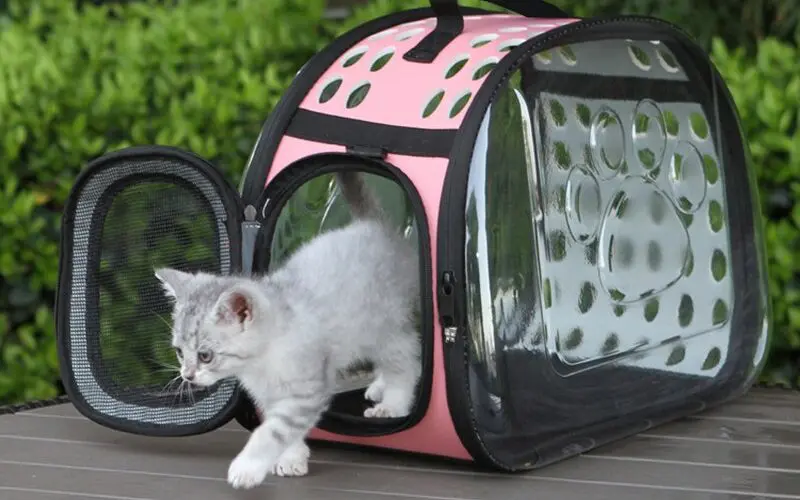
Start by getting a cat carrier if you don’t already have and slowly familiarize the cats to the carrier.
Have them sit on it every so often. Test if the carrier is fit and safe for long-distance travel by taking short trips within.
I suggest getting a multiple cat carrier if all your cats get along. Otherwise, individual carriers would still suffice if space in your car allows.
#2: Make an appointment with your vet
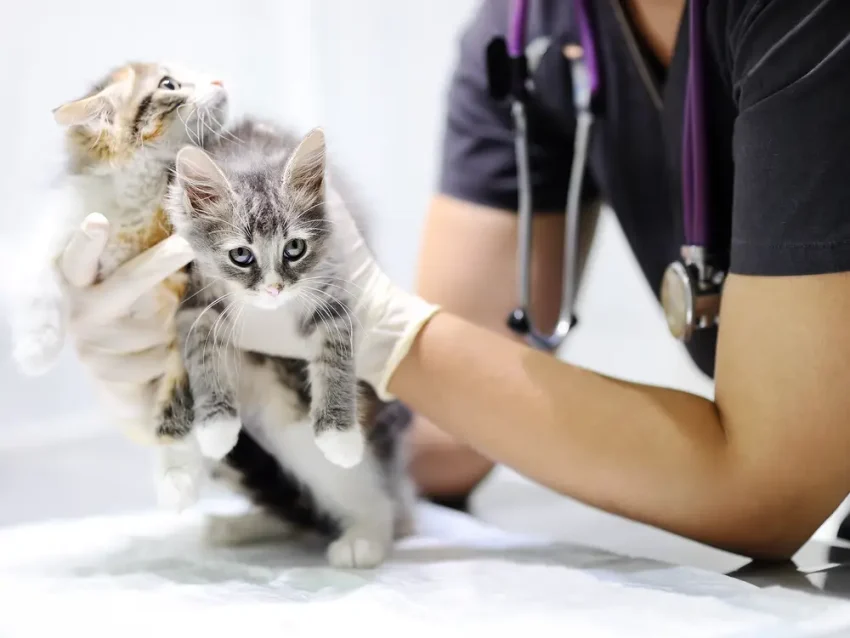
Talk to your vet and get any vaccinations recommended.
Your vet may also prescribe anxiety meds to help manage post-move anxiety.
Depending on the state you are moving to you may need to get certain certificates for all your cats to show that they have a clean bill of health.
#3: Choose the right time to travel
The best time to travel with your cat is during the daytime, when they are calmer.
In the early morning, it may take a few negotiations to get them in the carrier and in the car. Be sure to check the weather forecast, too.
You do not want to be caught up in the middle of the storm with your already anxious cats.
It will be a nightmare of a journey.
#4: Pack a “go” bag for your cats
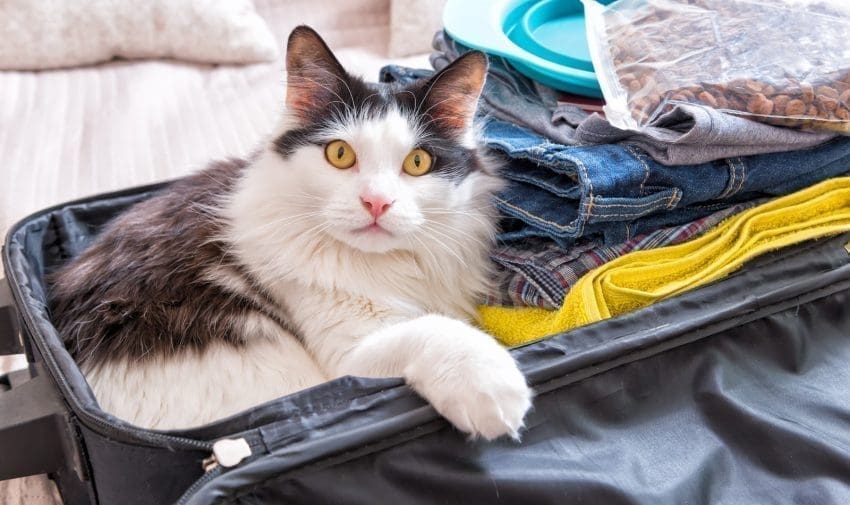
Carry with you your cat’s favorite treats, blankets, and toys to keep them occupied.
Having familiar items with them will keep them calm.
Have a separate identical toy for each cat, otherwise, they will start fighting over one.
They can, however, share a meal and play together.
#5: Don’t forget about potty breaks!
For long distances, I have always preferred disposal litter boxes.
They’re just a lot easier to manage! You can also line their regular litter box with waste bags.
That way, you can just scoop it all up and throw it away in one fell swoop.
Yes, it’s pricier than just scooping out waste as you go, but trust me, you don’t want a stinky litter box in your car!
If that’s just not feasible, you should eliminate cat litter box odors.
#6: Consider calming cat products
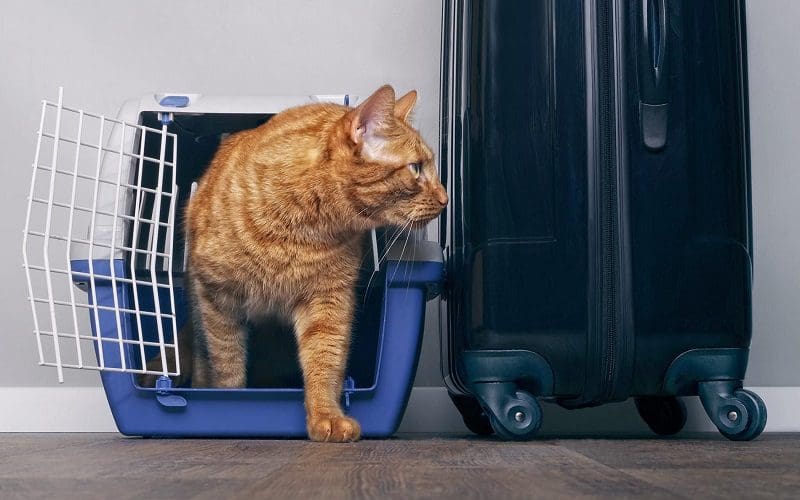
I’ve seen people recommend the use of pheromones and other calming cat products in the carrier to help calm the cats when on transit.
These products are simply synthetic versions of the cat’s facial pheromone that they produce to make a territory as safe.
You can also talk to your vet for natural solutions of keeping the cats calm.
#7 Never leave them alone or loose
Avoid leaving your cats alone in your car for longer than it takes to pay for gas or use the bathroom.
Grab food to go and eat in the car with them whenever possible. Or, if it’s a nice day, stop at a rest stop and eat at a picnic table.
Bring your cat’s carrier out next to you so they can get some fresh air, too.
Also, never leave them loose in the car! Always have them in the carrier the entire journey.
How long does it take a cat to adjust to a new home?
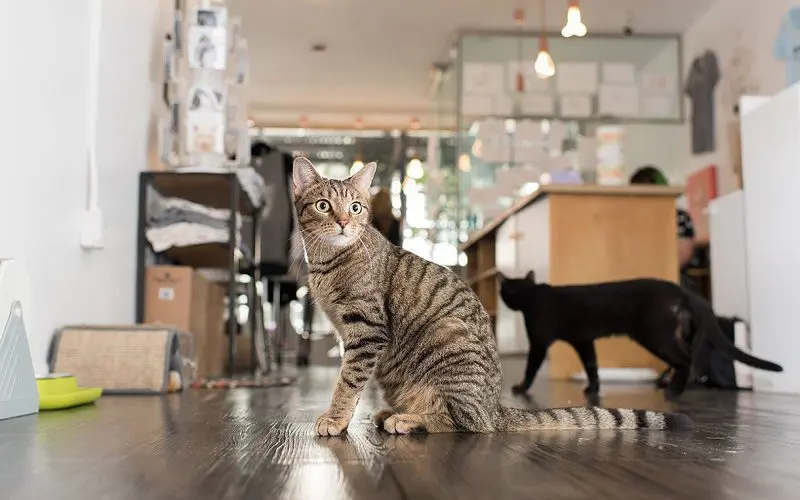
To be honest, there is no set timeline for a cat’s adjustment to a new home.
Every cat is different, and while some may adjust almost immediately, others may take a week or even a month.
There are variables though that you can use to approximate the timeline like age, personality among others. Generally, kittens adjust to new homes and environments way sooner than older cats.
This is because kittens are still curious and want to gain more exposure whereas older cats have their territories marked. A new move means no territory.
It takes older cats more time to acclimate and mark their new territory. Also, if your cat was not properly socialized prior to the move, it may take them longer to adjust.
In the worst-case, they may develop behavioral problems after the move. Also, if the cat had previously experienced any sort of trauma, abuse, or difficult past, it may have trouble feeling safe in its new home.
Another variable is the type of house you are moving into. If it’s bigger, smaller, or majorly different from what they were used to, it will definitely take them longer to adjust.
This goes for the outdoor environment too. Regardless of these variables, if the adjustment takes more than 4 weeks or longer, talk to your vet to help figure things out.
Your cat may be going through something deeper.
Tips to help your cats adjust to their new home
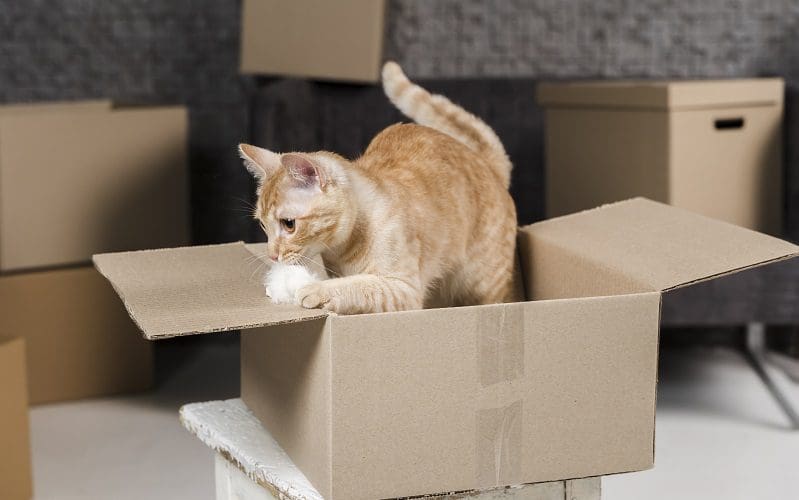
To help your cat adjust faster, keep him isolated for a few days in a separate room until the move is done and everything is well arranged.
Place everything they need in the room: food, litter, toys, water, and a scratching post. Make sure no one accesses the room but you (or close family) when feeding and playing with him
For multiple cats who get along so well, keeping them in the same room should be just fine. However, let them explore their new environment individually. A couple of hours for each on the same day.
Them being confined in a smaller space will give them time to get used to new smells, sights and sounds. This room also acts as their refuge when they feel anxious, lost, or stressed.
Gradually let them explore the new home at their own pace. Don’t force them to get out so they can explore; be patient and give them time.
Once they are ready they will. Be keen on their behavior, though; if one or both seem so tensed and anxious, lock them up separately so that each can have alone time to process the new changes.
If possible, move everything else to the new home before taking your cats. The commotion, strangers, noise, and unfamiliarity may stress them even more.
Cats are generally habitual animals so try to keep their routine as stable as you can immediately after the move.
Aside from their bed, blanket, and toys, place one of your items in the room like an old T-shirt or any other item with a heavy scent of you or your previous home.
This will help in making them feel safe and lessen their anxiety. Most importantly, ensure the new space is cat-friendly.
Cats, when stressed and overwhelmed, can do everything they can to escape. Keep all windows and doors closed, and don’t be tempted to take them out until they are comfortable in the new environment.
Inspect if the outdoor is safe, are there any poisonous plants in the back or front yard. You should check out a list of poisonous plants to know exactly what you are looking out for.
Before you allow your cats to step out of the house, have them tagged with the new address and contacts.
Moving an older cat to a new home
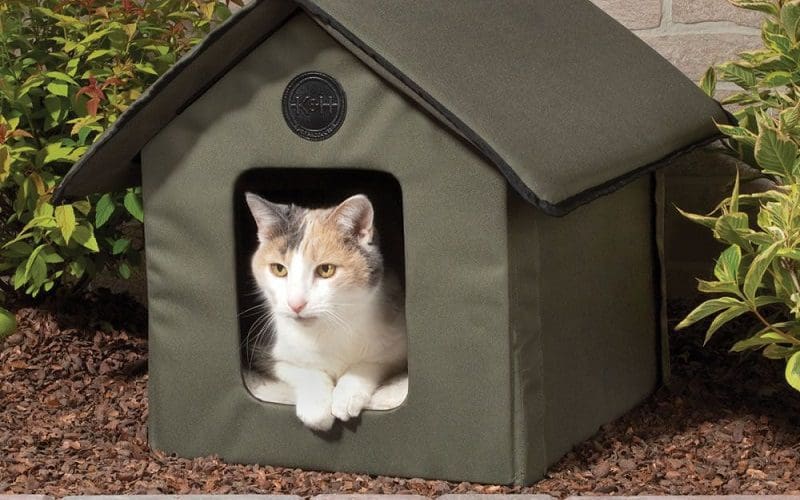
Older cats are never a big fan of change. They would rather be in the same home forever.
It will take you a lot more to move an older cat to a new home than it would a kitty because they have built strong territorial skills.
You will follow the same tips shared above only that you have to be extra keen on their health and behavioral changes.
The change can be very unsettling that it leads to depression or affect their health.
You also have to be loads patient when introducing him to his new home. Ensure that it’s a very gradual process. Don’t panic, don’t stress, relax otherwise your cat will pick on your emotions and stress.
I find that putting familiar items in their isolation room really works with senior cats. Your clothing items, their old blankets, anything with a scent that reminds them of their old home will work.
Temporary Moves with Cats
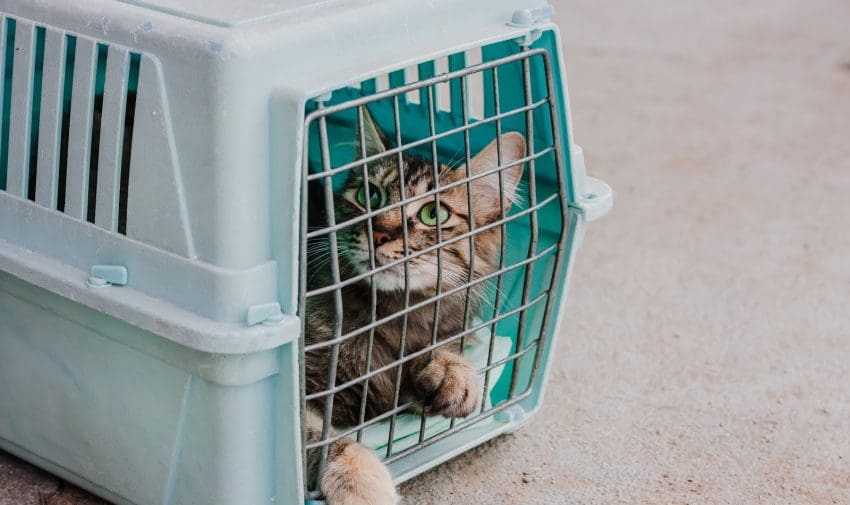
What if the move is just a temporary one? What if you plan on coming back to your home after some time?
Unless the temporary move is significantly longer, it’s best to have someone pet sit your cat until you are back.
It is not worth the hassle of moving with your cat and helping them get settled then moving back again.
If the temporary move is longer than 3 months, approach it just as you would when moving a cat into a new place.
Coming back to your old home should be an easy transition for your cat since its a very familiar environment.
Your cat may be confused a bit for some days but that’s just about it.
Moving a cat to a new owner

Moving your cat to a new home and new owner is a whole different ball game as your cat will be dealing with a totally unfamiliar environment and unfamiliar faces.
If possible, meet or phone the new owner to give a brief history of your cat.
Let him know things like the food he likes, quirky behaviors he has, mealtime and playtime routines, pre-existing conditions, whether your cat is an outdoor or totally indoor cat, and so forth.
Take him along with his litterbox, bed, blanket, toys, and all his familiar items.
Having familiar items in a strange place is comforting to the cat. Also, toys help a great deal with relieving stress.
As long as a cat feels safe, whether in a new home or with a new owner, he should gradually get comfortable and bounce back to their old self.
In a month’s time at the very most, the cat should have adopted pretty well if allowed to adjust at their own pace.
Signs that your cat is stressed out after the move

Even after trying everything to make the move seamless for your cats, one or two may have it rough.
- Excessive meowing and purring
- Excessive scratching and grooming
- Total withdrawal
- Heavy panting and abnormal drooling
- Runny eyes and nose
- Loose stool
- Not feeding as usual
- Lethargy
- Spraying
- Aggression and spraying
- Not using their litter correctly
If you notice more than one of these signs over a couple of days, I suggest you talk to your vet.
Conclusion
Moving with multiple cats is not as difficult as many anticipate, as long as you pre-plan yourself.
If you follow our guide, it should take a couple of days to two weeks at most for your cats to adjust.
Try as much as possible to make the move seamless by keeping your cats locked up until you are done packing and loading the truck.
Once in your new home, lock them up safely in a room until you are settled in. Be patient, you’ll realize that when left to adjust at their own pace, your cats will bounce back pretty fast.
Before you know it, they’ll be totally comfortable in their new territory. Do you have any other tips for moving with multiple cats? Share below!
Resources:


Olfa knows how to get things done and has a keen business sense that others admire. She’s always on the go, coming up with new ideas! Her ability to anticipate the needs of her readers and deliver information that they want is what makes CatVills such a success. She loves cuddling her cat Picaciu. He is her inspiration.
